Comments/Ratings for a Single Item
 H. G. Muller wrote on Mon, May 22, 2023 06:09 PM UTC in reply to Diceroller is Fire from 05:40 PM:
H. G. Muller wrote on Mon, May 22, 2023 06:09 PM UTC in reply to Diceroller is Fire from 05:40 PM:So I really don’t understand, what have I done if you ignore my submissions?
Nothing in particular. But I don't consider it my task here to judge and publish submissions. I do only look at those when I have time, and only comment on them when I notice something that should be pointed out. And at the moment I am pretty busy because I have been on holiday, and am furthermore working on writing articles for two variants of my own.
So for me, piece is more valuable if it’s easier and more possible to checkmate in pure late endgame.
If ease of checkmating would be a criterion, you would probably consider a Rook more valuable than an Archbishop. And Knights and Bishops would not be worth anything at all, as these cannot force checkmate. But to get into a position where you can force checkmate, you first have to gain the material advantage that requires. You cannot do that if you sacrifice the more powerful pieces for weaker ones just because the weaker ones are easier to checkmate with. If you do that, you would get checkmated yourself. So it is important to both know correct piece values, and master elementary checkmates.
So 7 is very weird number: I’ve claimed Hyperrook (RF), Archbishop (BN) and Magician as 7 in my own notation (which BTW has Manchu Superpiece and hasn’t Amazon), but now I watch and see that they all can cost 8 depending on situation; so I’m thinking about marking Nightrider, Squirrel and Unicorn as 7, but I don’t want to do it.
I will stop this discussion to not drown in it)
One theoretical curiosity is that there is the old rule of thumb (from gambit openings!?) that in open positions, a tempo is worth 1/3 of a pawn. If we accept that the bishop pair is worth half a pawn then it would seem that gaining it is usually(?) worth more than investing a tempo in an open position.
In closed positions, presumably with time not being as vital (usually), a tempo would be worth less than a third of a pawn. Yet, the Nimzo-Indian (1.d2-d4 Ng8-f6 2.c2-c4 e7-e6 3.Nb1-c3 Bf8-b4) is a highly respected black defence in closed games, with black often happily allowing white to gain the B-pair for (virtually) a tempo (or sometimes not even for that), namely via a2-a3 by White (not too useful a move usually, except for inducing the trade). Any other factors involved in assessing the huge variety of positions arising from this opening are less permanent or constant, perhaps, maybe with the exception that there is the initial fight for the centre being engaged in by black. If assessing values is that sensitive, I still wonder how reliable computer studies are, with the initial positions of the setups chosen maybe not being always nearly complete enough.
Material cost is the cost of pieces, or used in a specific situation by summoning unit for some card games. If one of material costs is higher than another piece, this one is more powerful, but heavier than another. Another way of saying, one which has a low material cost, it is more light and movable, and easy to exchange for higher costs. For example, material costs(Material Cost) of knight is 6. ,the pawn have 1 material.
How is calculating material costs mathematically.
Let’s suppose a checked board in your hands. Adjust it to 7×7 squares.
(a1,a3,a5,a7,b2,b4,b6,c1,c3,c5,c7,d2,d4,d6,e1,e3,e5,e7,f2,f4,f6,g1,g3,g5,g7)=|A|
(a2,a4,a6,b1,b3,b5,b7,c2,c4,c6,d1,d3,d5,d7,e2,e4,e6,f1,f3,f5,f7,g2,g4,g6)=|B|
+—+—+—+
|c1|b1|a1|
+—+—+—+
|c2|b2|a2|
+—+—+—+
|c3|b3|a3|
+—+—+—+
|A| and |B| are an assembly element.
Put a piece you want calculate on the d4 central. You can analyze movements of the piece to a part. And you can apply this movements into each squares, (ranks and files). These motion elements are parted into Leap, Ride, Hurdle, Capture only and Move only.
In particularly, the special ability which have various pieces, for example warp, is regarded as special ability elements, these are stood for a letter .
The following list are symbols of the elements.
Ⓛ: Leap Ⓡ: Ride ☐: Hurdle ×: Capture only △: Move only A: Capture without move B: Muti-capture without move C: Copy I: Imitate P: Push R: Reverse S: Sky T: Turn around X: Stop Y: Warp
All elements are able to calculate, a pawn with one step orthogonal capture and one step diagonal move, in this situation pawn cannot move double step at the initial movement, which have △ in d3 and × in c3, e3. So, the following expression is made up.
Pawn=(△)•(d3)+(×)•(c3)+(×)•(e3)
A king moves one step orthogonally and diagonally, it means Ⓛ in c3, c4, c5, d3, d5, e3, e4, e5.
King=(Ⓛ)•(c3)+(Ⓛ)•(c4)+(Ⓛ)•(c5)+(Ⓛ)•(d3)+(Ⓛ)•(d5)+(Ⓛ)•(e3)+(Ⓛ)•(e4)+(Ⓛ)•(e5)
Next, I want show a list of the operation process numbers.
(|A|)=1/2 (|B|)=1 (Ⓛ)=1 (Ⓡ)=1/2 (☐)=1/2 (×)=1/2 (△)=1/2 (A)=1/2 (B)=1 (C)=1 (I)=1/2 (P)=1/2 (R)=1 (S)=1/2 (T)=1 (X)=1 (Y)=1
Next, I want explain for calculation of material cost about Rider.
In general, rider is known as a series of same direction leaps as far as the board will allow, each of which must be to an empty spaces.
Well, which the initial step of rider is the some of Leap or Ride, et cetera. It is possible that both Leap and Ride. In case of general rider; bishop and rook, the initial step is Leap. In case of circular rider; rose, the initial step is Ride.
As well, rider that move by crawling under ground; bishop, rook or queen, and another type of rider that move by interval jumping; nightrider, exist. The first type of rider is calculated by 11×11 squares checked board, and second type of rider is by 13×13.
(A1,a3,a5,a7,a9,a11,b2,b4,b6,b8,b10,c1,c3,c5,c7,c9,c11,d2,d4,d6,d8,d10,e1,e3,e5,e7,e9,e11,f2,f4,f6,f8,f10,g1,g3,g5,g7,g9,g11,h2,h4,h6,h8,h10,i1,i3,i5,i7,i9,i11,j2,j4,j6,j8,j10,k1,k3,k5,k7,k9,k11)=|A|
(a2,a4,a6,a8,a10,b1,b3,b5,b7,b9,b11,c2,c4,c6,c8,c10,d1,d3,d5,d7,d9,d11,e2,e4,e6,e8,e10,f1,f3,f5,f7,f9,f11,g2,g4,g6,g8,g10,h1,h3,h5,h7,h9,h11,i2,i4,i6,i8,i10,j1,j3,j5,j7,j9,j11,k2,k4,k6,k8,k10)=|B|
The central is f6.
I want to explain the calculation for rook.
Ⓛ in e6, f5, f7, g6. Ⓡ in a6, b6, c6, d6, f1, f2, f3, f4, f8, f9, f10, f11, h6, i6, j6, k6
Rook=(Ⓛ)•{(e6)+(f5)+(f7)+(g6)}+(Ⓡ)•{(a6)+(b6)+(c6)+(d6)+(f1)+(f2)+(f3)+(f4)+(f8)+(f9)+(f10)+(f11)+(h6)+(i6)+(j6)+(k6)}
Super Symmetry Correction; SSC, for the type of Knights and Nightrider. Knight and nightrider have 9 symmetries and this is maximum numbers.So, you can correct these material costs.
(SSC)=-2
Pawn=1 King=6 Queen=16 Bishop=6 Knight=6 Rook=10
Returning to our discussion;))))))) I’ve understood that:
- Archbishop costs 8 because it also covers neighboring squares (earlier I thought of it as of BFX discarding the nearness of covered squares); in my opinion it's because B part is long ranging (discarding N's moving's shortness) and N part is color-switching (discarding B's colorboundness) and jumping; so it is maneuverable. So Bishop's part there is 4, however Knight's one is also 4!
- Imbalance of A+p > Q probably exists because Pawn is cooperative and "every pawn is potential Queen"(c)
- Ultrabishop (BW) and Hyperrook (RF) are 7 and 8 relatively, because they BTW include the Doubler (K) moves (I thought of them like about BH or RA/RG discarding the nearness of covered squares).
- Nightrider and Rook really have similar mobility on 8x8, but Nightrider is more maneuverable and Rook is more reliable.
- Both Zip and Magician from Horizons have the cost of 9 on large (but not big) and free boards, but on 8x8 they really are 7 (M) and 8 (Z) because of their maneuverability and defense from the King (compare with Queen).
- Bishop pair costs between 6,5 and 7 (when board is more free, Bishops' pair is more valuable).
- Silver isn't as stabile in cost as I've thought before (in Orda Chess, it's Yurt which is decided to cost 2, but I disagree – maybe from 2,6 to 3,2).
What do you think about?
My Original New Shogi
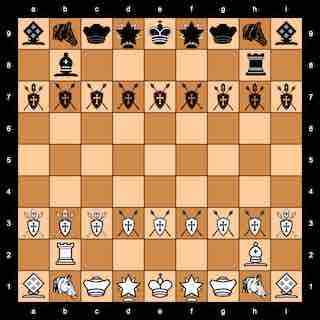
Transformed Side

King

Soldier


General

Admiral

Cavalry

Knight

Bishop

Inquisitor
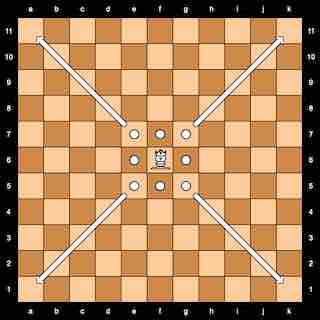
Barrier
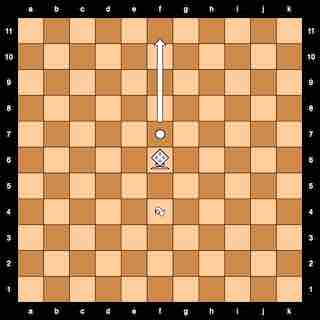
Gate
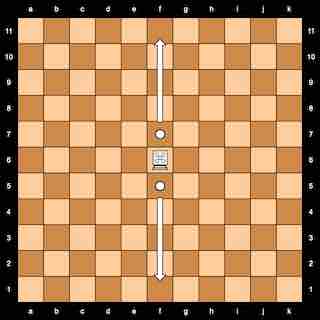
Rook

Castle

Material Cost
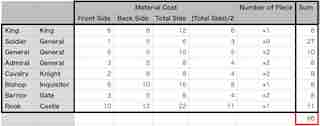
Transformed Side Other Variation

Captain

This is a non-royal piece but moves as a King.
Cavalry transforms to Bishop(b1 and h9) or Captain(h1 and b9).
I just recently developed an Inquisitor piece, moving BDC.
(I just thought I'd mention it, in case it matters to you.)
Bob Greenwade wrote on 2023-09-20 UTC
Thanks, I have just noticed that you are right.
11 comments displayed
Permalink to the exact comments currently displayed.

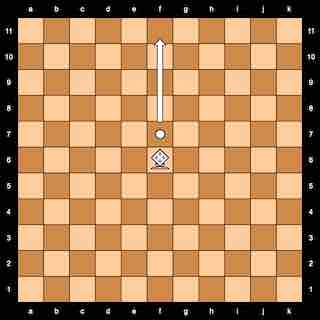
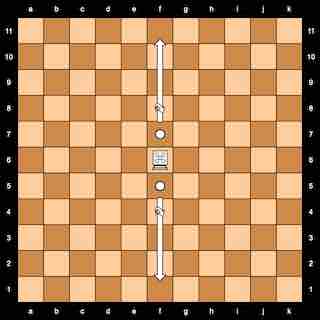

So stalemate possibility also matters. So for me, piece is more valuable if it’s easier and more possible to checkmate in pure late endgame.
So I really don’t understand, what have I done if you ignore my submissions?